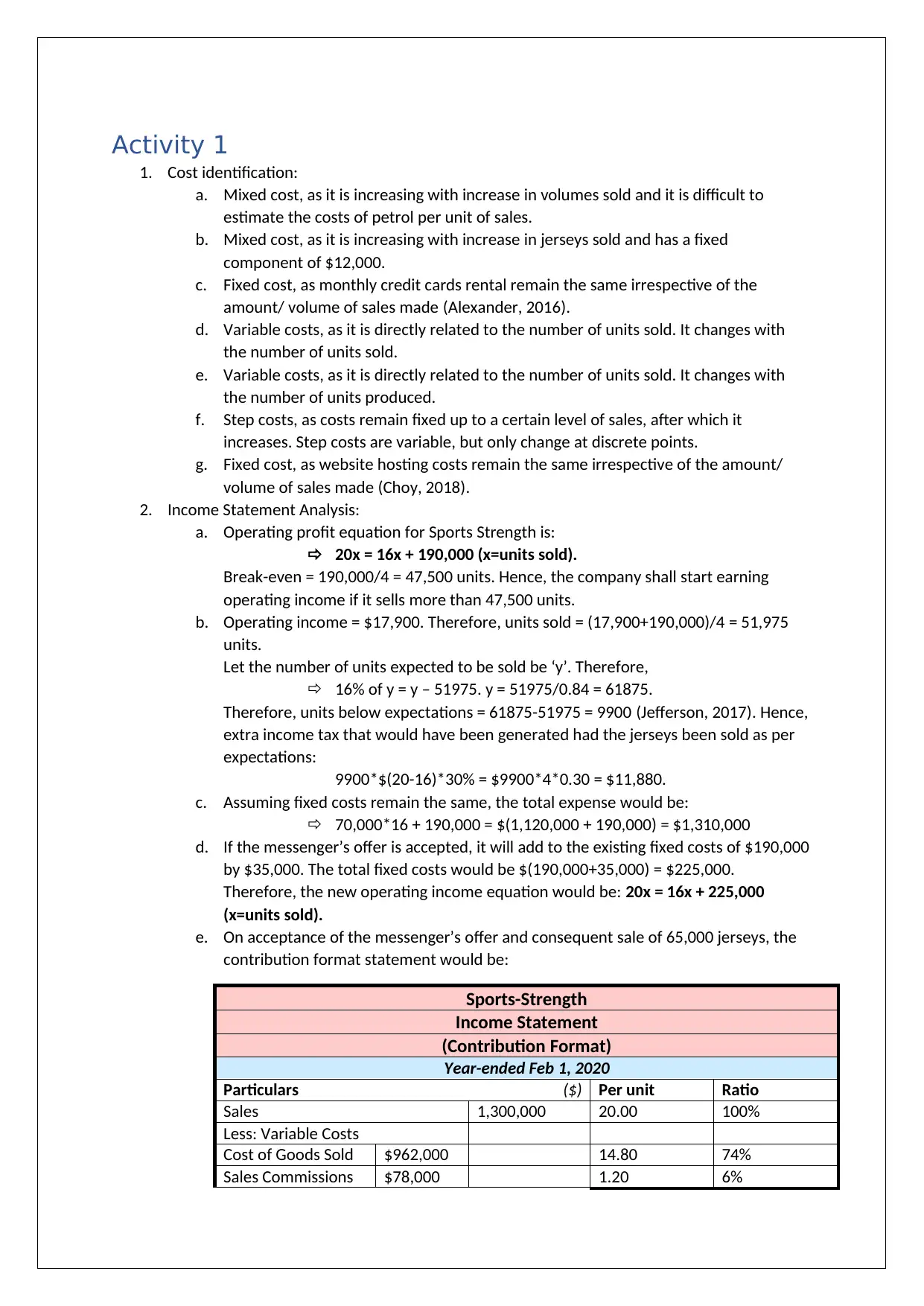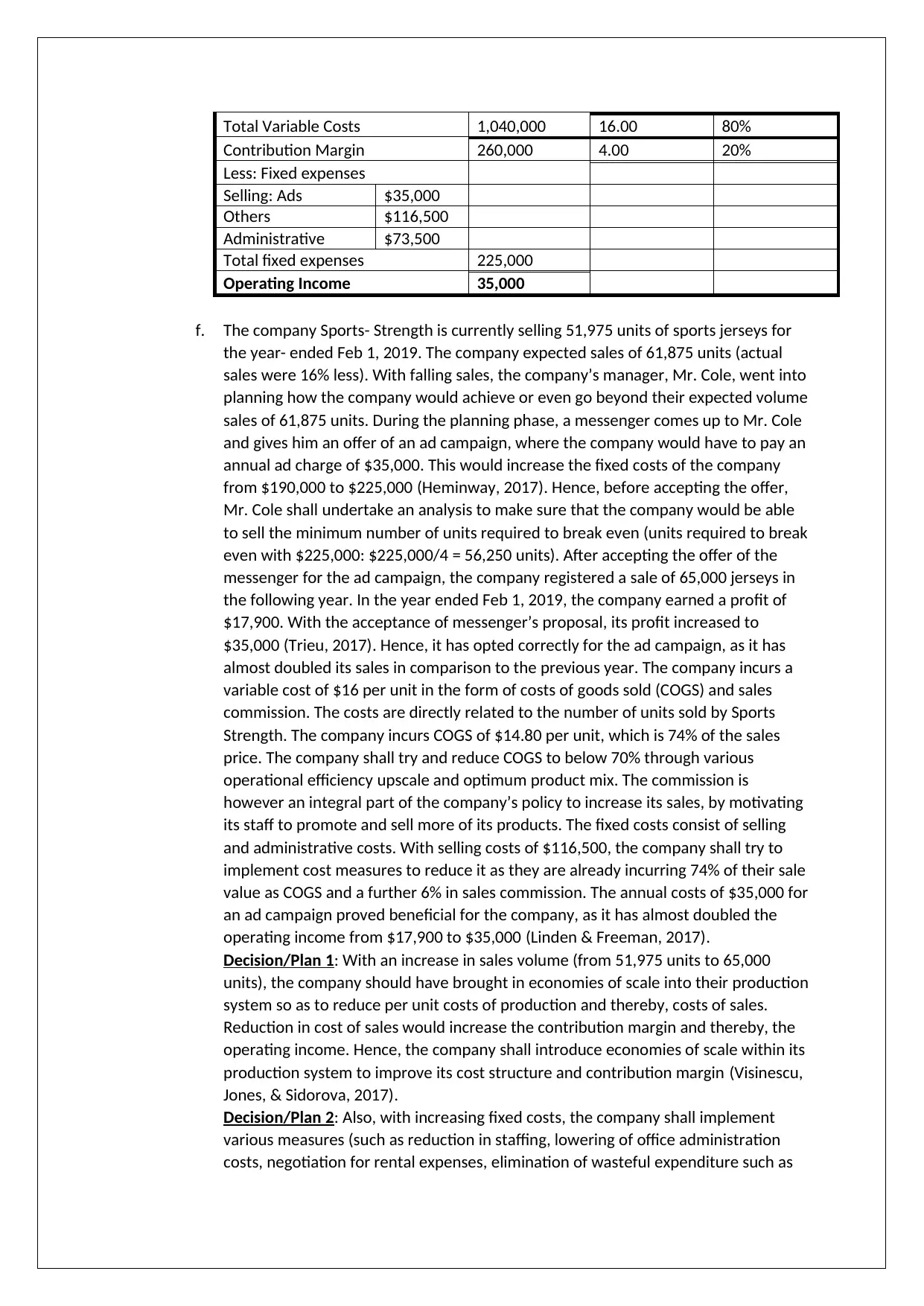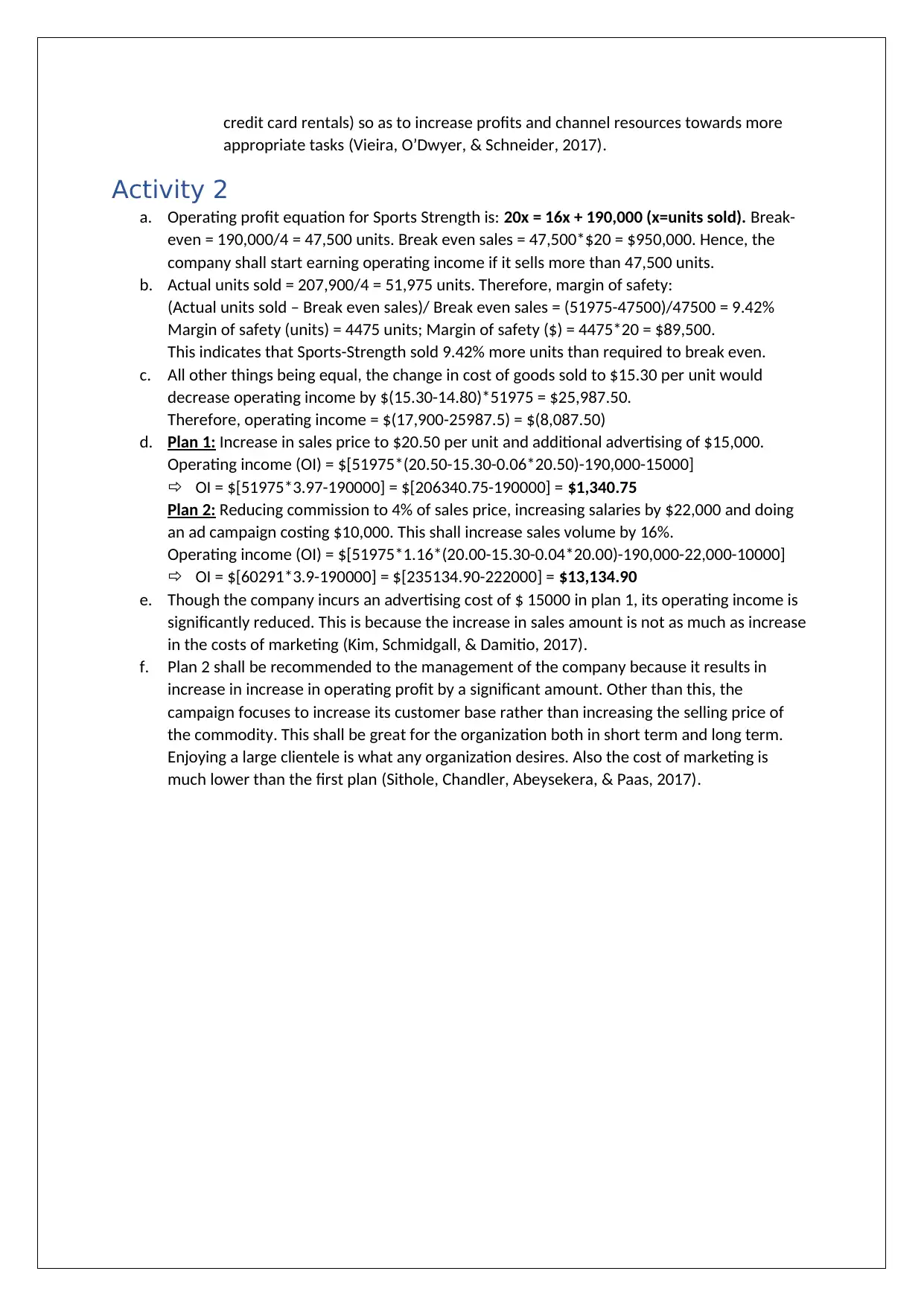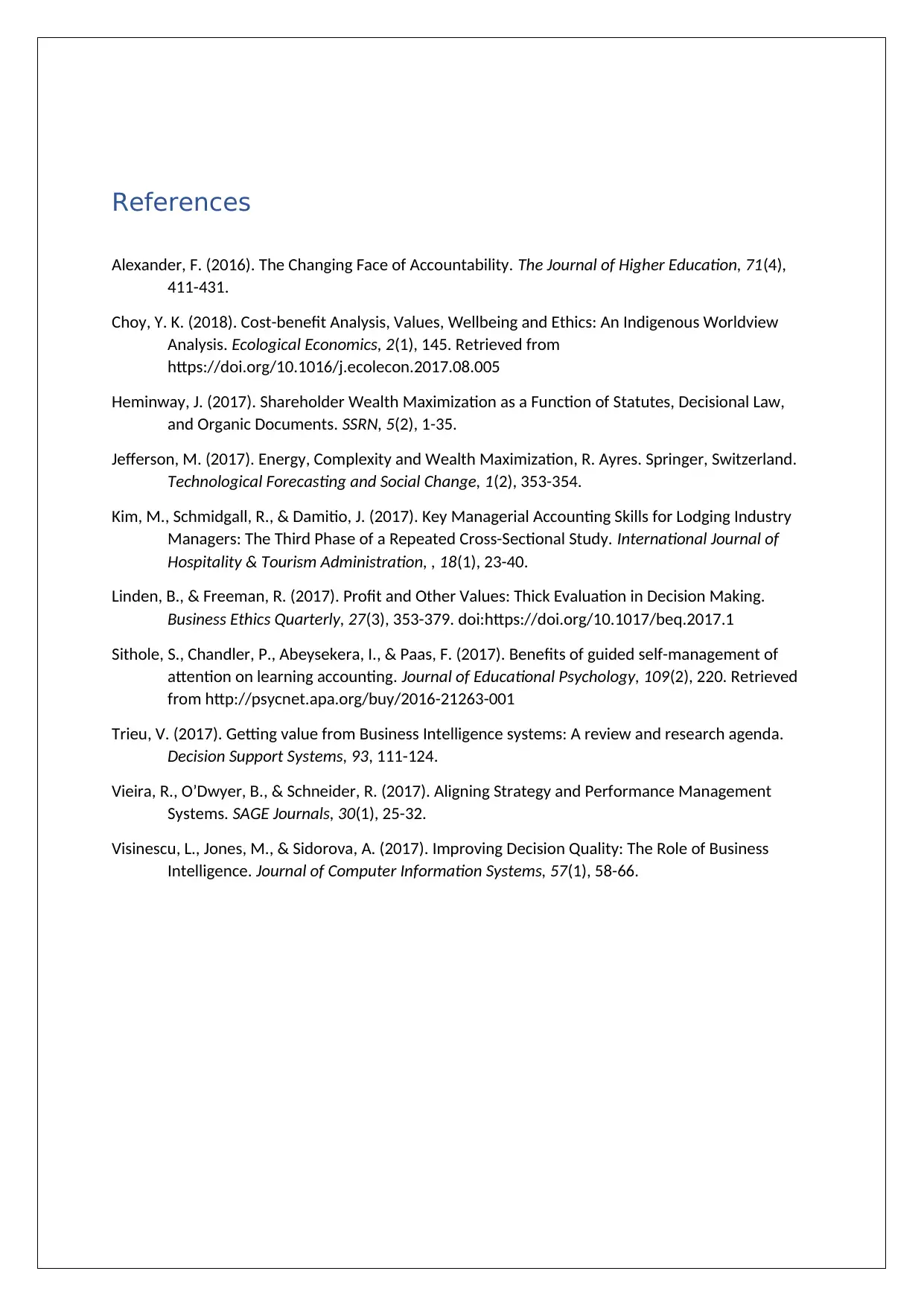Cost Identification and Income Statement Analysis
VerifiedAdded on 2023/01/18
|4
|2003
|54
AI Summary
This article discusses cost identification and income statement analysis for Sports Strength. It explains the different types of costs and their impact on operating income. It also calculates the break-even point and margin of safety. The article presents two plans to increase operating profit and recommends the more effective plan. References are provided for further reading.
Contribute Materials
Your contribution can guide someone’s learning journey. Share your
documents today.

Activity 1
1. Cost identification:
a. Mixed cost, as it is increasing with increase in volumes sold and it is difficult to
estimate the costs of petrol per unit of sales.
b. Mixed cost, as it is increasing with increase in jerseys sold and has a fixed
component of $12,000.
c. Fixed cost, as monthly credit cards rental remain the same irrespective of the
amount/ volume of sales made (Alexander, 2016).
d. Variable costs, as it is directly related to the number of units sold. It changes with
the number of units sold.
e. Variable costs, as it is directly related to the number of units sold. It changes with
the number of units produced.
f. Step costs, as costs remain fixed up to a certain level of sales, after which it
increases. Step costs are variable, but only change at discrete points.
g. Fixed cost, as website hosting costs remain the same irrespective of the amount/
volume of sales made (Choy, 2018).
2. Income Statement Analysis:
a. Operating profit equation for Sports Strength is:
20x = 16x + 190,000 (x=units sold).
Break-even = 190,000/4 = 47,500 units. Hence, the company shall start earning
operating income if it sells more than 47,500 units.
b. Operating income = $17,900. Therefore, units sold = (17,900+190,000)/4 = 51,975
units.
Let the number of units expected to be sold be ‘y’. Therefore,
16% of y = y – 51975. y = 51975/0.84 = 61875.
Therefore, units below expectations = 61875-51975 = 9900 (Jefferson, 2017). Hence,
extra income tax that would have been generated had the jerseys been sold as per
expectations:
9900*$(20-16)*30% = $9900*4*0.30 = $11,880.
c. Assuming fixed costs remain the same, the total expense would be:
70,000*16 + 190,000 = $(1,120,000 + 190,000) = $1,310,000
d. If the messenger’s offer is accepted, it will add to the existing fixed costs of $190,000
by $35,000. The total fixed costs would be $(190,000+35,000) = $225,000.
Therefore, the new operating income equation would be: 20x = 16x + 225,000
(x=units sold).
e. On acceptance of the messenger’s offer and consequent sale of 65,000 jerseys, the
contribution format statement would be:
Sports-Strength
Income Statement
(Contribution Format)
Year-ended Feb 1, 2020
Particulars ($) Per unit Ratio
Sales 1,300,000 20.00 100%
Less: Variable Costs
Cost of Goods Sold $962,000 14.80 74%
Sales Commissions $78,000 1.20 6%
1. Cost identification:
a. Mixed cost, as it is increasing with increase in volumes sold and it is difficult to
estimate the costs of petrol per unit of sales.
b. Mixed cost, as it is increasing with increase in jerseys sold and has a fixed
component of $12,000.
c. Fixed cost, as monthly credit cards rental remain the same irrespective of the
amount/ volume of sales made (Alexander, 2016).
d. Variable costs, as it is directly related to the number of units sold. It changes with
the number of units sold.
e. Variable costs, as it is directly related to the number of units sold. It changes with
the number of units produced.
f. Step costs, as costs remain fixed up to a certain level of sales, after which it
increases. Step costs are variable, but only change at discrete points.
g. Fixed cost, as website hosting costs remain the same irrespective of the amount/
volume of sales made (Choy, 2018).
2. Income Statement Analysis:
a. Operating profit equation for Sports Strength is:
20x = 16x + 190,000 (x=units sold).
Break-even = 190,000/4 = 47,500 units. Hence, the company shall start earning
operating income if it sells more than 47,500 units.
b. Operating income = $17,900. Therefore, units sold = (17,900+190,000)/4 = 51,975
units.
Let the number of units expected to be sold be ‘y’. Therefore,
16% of y = y – 51975. y = 51975/0.84 = 61875.
Therefore, units below expectations = 61875-51975 = 9900 (Jefferson, 2017). Hence,
extra income tax that would have been generated had the jerseys been sold as per
expectations:
9900*$(20-16)*30% = $9900*4*0.30 = $11,880.
c. Assuming fixed costs remain the same, the total expense would be:
70,000*16 + 190,000 = $(1,120,000 + 190,000) = $1,310,000
d. If the messenger’s offer is accepted, it will add to the existing fixed costs of $190,000
by $35,000. The total fixed costs would be $(190,000+35,000) = $225,000.
Therefore, the new operating income equation would be: 20x = 16x + 225,000
(x=units sold).
e. On acceptance of the messenger’s offer and consequent sale of 65,000 jerseys, the
contribution format statement would be:
Sports-Strength
Income Statement
(Contribution Format)
Year-ended Feb 1, 2020
Particulars ($) Per unit Ratio
Sales 1,300,000 20.00 100%
Less: Variable Costs
Cost of Goods Sold $962,000 14.80 74%
Sales Commissions $78,000 1.20 6%
Secure Best Marks with AI Grader
Need help grading? Try our AI Grader for instant feedback on your assignments.

Total Variable Costs 1,040,000 16.00 80%
Contribution Margin 260,000 4.00 20%
Less: Fixed expenses
Selling: Ads $35,000
Others $116,500
Administrative $73,500
Total fixed expenses 225,000
Operating Income 35,000
f. The company Sports- Strength is currently selling 51,975 units of sports jerseys for
the year- ended Feb 1, 2019. The company expected sales of 61,875 units (actual
sales were 16% less). With falling sales, the company’s manager, Mr. Cole, went into
planning how the company would achieve or even go beyond their expected volume
sales of 61,875 units. During the planning phase, a messenger comes up to Mr. Cole
and gives him an offer of an ad campaign, where the company would have to pay an
annual ad charge of $35,000. This would increase the fixed costs of the company
from $190,000 to $225,000 (Heminway, 2017). Hence, before accepting the offer,
Mr. Cole shall undertake an analysis to make sure that the company would be able
to sell the minimum number of units required to break even (units required to break
even with $225,000: $225,000/4 = 56,250 units). After accepting the offer of the
messenger for the ad campaign, the company registered a sale of 65,000 jerseys in
the following year. In the year ended Feb 1, 2019, the company earned a profit of
$17,900. With the acceptance of messenger’s proposal, its profit increased to
$35,000 (Trieu, 2017). Hence, it has opted correctly for the ad campaign, as it has
almost doubled its sales in comparison to the previous year. The company incurs a
variable cost of $16 per unit in the form of costs of goods sold (COGS) and sales
commission. The costs are directly related to the number of units sold by Sports
Strength. The company incurs COGS of $14.80 per unit, which is 74% of the sales
price. The company shall try and reduce COGS to below 70% through various
operational efficiency upscale and optimum product mix. The commission is
however an integral part of the company’s policy to increase its sales, by motivating
its staff to promote and sell more of its products. The fixed costs consist of selling
and administrative costs. With selling costs of $116,500, the company shall try to
implement cost measures to reduce it as they are already incurring 74% of their sale
value as COGS and a further 6% in sales commission. The annual costs of $35,000 for
an ad campaign proved beneficial for the company, as it has almost doubled the
operating income from $17,900 to $35,000 (Linden & Freeman, 2017).
Decision/Plan 1: With an increase in sales volume (from 51,975 units to 65,000
units), the company should have brought in economies of scale into their production
system so as to reduce per unit costs of production and thereby, costs of sales.
Reduction in cost of sales would increase the contribution margin and thereby, the
operating income. Hence, the company shall introduce economies of scale within its
production system to improve its cost structure and contribution margin (Visinescu,
Jones, & Sidorova, 2017).
Decision/Plan 2: Also, with increasing fixed costs, the company shall implement
various measures (such as reduction in staffing, lowering of office administration
costs, negotiation for rental expenses, elimination of wasteful expenditure such as
Contribution Margin 260,000 4.00 20%
Less: Fixed expenses
Selling: Ads $35,000
Others $116,500
Administrative $73,500
Total fixed expenses 225,000
Operating Income 35,000
f. The company Sports- Strength is currently selling 51,975 units of sports jerseys for
the year- ended Feb 1, 2019. The company expected sales of 61,875 units (actual
sales were 16% less). With falling sales, the company’s manager, Mr. Cole, went into
planning how the company would achieve or even go beyond their expected volume
sales of 61,875 units. During the planning phase, a messenger comes up to Mr. Cole
and gives him an offer of an ad campaign, where the company would have to pay an
annual ad charge of $35,000. This would increase the fixed costs of the company
from $190,000 to $225,000 (Heminway, 2017). Hence, before accepting the offer,
Mr. Cole shall undertake an analysis to make sure that the company would be able
to sell the minimum number of units required to break even (units required to break
even with $225,000: $225,000/4 = 56,250 units). After accepting the offer of the
messenger for the ad campaign, the company registered a sale of 65,000 jerseys in
the following year. In the year ended Feb 1, 2019, the company earned a profit of
$17,900. With the acceptance of messenger’s proposal, its profit increased to
$35,000 (Trieu, 2017). Hence, it has opted correctly for the ad campaign, as it has
almost doubled its sales in comparison to the previous year. The company incurs a
variable cost of $16 per unit in the form of costs of goods sold (COGS) and sales
commission. The costs are directly related to the number of units sold by Sports
Strength. The company incurs COGS of $14.80 per unit, which is 74% of the sales
price. The company shall try and reduce COGS to below 70% through various
operational efficiency upscale and optimum product mix. The commission is
however an integral part of the company’s policy to increase its sales, by motivating
its staff to promote and sell more of its products. The fixed costs consist of selling
and administrative costs. With selling costs of $116,500, the company shall try to
implement cost measures to reduce it as they are already incurring 74% of their sale
value as COGS and a further 6% in sales commission. The annual costs of $35,000 for
an ad campaign proved beneficial for the company, as it has almost doubled the
operating income from $17,900 to $35,000 (Linden & Freeman, 2017).
Decision/Plan 1: With an increase in sales volume (from 51,975 units to 65,000
units), the company should have brought in economies of scale into their production
system so as to reduce per unit costs of production and thereby, costs of sales.
Reduction in cost of sales would increase the contribution margin and thereby, the
operating income. Hence, the company shall introduce economies of scale within its
production system to improve its cost structure and contribution margin (Visinescu,
Jones, & Sidorova, 2017).
Decision/Plan 2: Also, with increasing fixed costs, the company shall implement
various measures (such as reduction in staffing, lowering of office administration
costs, negotiation for rental expenses, elimination of wasteful expenditure such as

credit card rentals) so as to increase profits and channel resources towards more
appropriate tasks (Vieira, O’Dwyer, & Schneider, 2017).
Activity 2
a. Operating profit equation for Sports Strength is: 20x = 16x + 190,000 (x=units sold). Break-
even = 190,000/4 = 47,500 units. Break even sales = 47,500*$20 = $950,000. Hence, the
company shall start earning operating income if it sells more than 47,500 units.
b. Actual units sold = 207,900/4 = 51,975 units. Therefore, margin of safety:
(Actual units sold – Break even sales)/ Break even sales = (51975-47500)/47500 = 9.42%
Margin of safety (units) = 4475 units; Margin of safety ($) = 4475*20 = $89,500.
This indicates that Sports-Strength sold 9.42% more units than required to break even.
c. All other things being equal, the change in cost of goods sold to $15.30 per unit would
decrease operating income by $(15.30-14.80)*51975 = $25,987.50.
Therefore, operating income = $(17,900-25987.5) = $(8,087.50)
d. Plan 1: Increase in sales price to $20.50 per unit and additional advertising of $15,000.
Operating income (OI) = $[51975*(20.50-15.30-0.06*20.50)-190,000-15000]
OI = $[51975*3.97-190000] = $[206340.75-190000] = $1,340.75
Plan 2: Reducing commission to 4% of sales price, increasing salaries by $22,000 and doing
an ad campaign costing $10,000. This shall increase sales volume by 16%.
Operating income (OI) = $[51975*1.16*(20.00-15.30-0.04*20.00)-190,000-22,000-10000]
OI = $[60291*3.9-190000] = $[235134.90-222000] = $13,134.90
e. Though the company incurs an advertising cost of $ 15000 in plan 1, its operating income is
significantly reduced. This is because the increase in sales amount is not as much as increase
in the costs of marketing (Kim, Schmidgall, & Damitio, 2017).
f. Plan 2 shall be recommended to the management of the company because it results in
increase in increase in operating profit by a significant amount. Other than this, the
campaign focuses to increase its customer base rather than increasing the selling price of
the commodity. This shall be great for the organization both in short term and long term.
Enjoying a large clientele is what any organization desires. Also the cost of marketing is
much lower than the first plan (Sithole, Chandler, Abeysekera, & Paas, 2017).
appropriate tasks (Vieira, O’Dwyer, & Schneider, 2017).
Activity 2
a. Operating profit equation for Sports Strength is: 20x = 16x + 190,000 (x=units sold). Break-
even = 190,000/4 = 47,500 units. Break even sales = 47,500*$20 = $950,000. Hence, the
company shall start earning operating income if it sells more than 47,500 units.
b. Actual units sold = 207,900/4 = 51,975 units. Therefore, margin of safety:
(Actual units sold – Break even sales)/ Break even sales = (51975-47500)/47500 = 9.42%
Margin of safety (units) = 4475 units; Margin of safety ($) = 4475*20 = $89,500.
This indicates that Sports-Strength sold 9.42% more units than required to break even.
c. All other things being equal, the change in cost of goods sold to $15.30 per unit would
decrease operating income by $(15.30-14.80)*51975 = $25,987.50.
Therefore, operating income = $(17,900-25987.5) = $(8,087.50)
d. Plan 1: Increase in sales price to $20.50 per unit and additional advertising of $15,000.
Operating income (OI) = $[51975*(20.50-15.30-0.06*20.50)-190,000-15000]
OI = $[51975*3.97-190000] = $[206340.75-190000] = $1,340.75
Plan 2: Reducing commission to 4% of sales price, increasing salaries by $22,000 and doing
an ad campaign costing $10,000. This shall increase sales volume by 16%.
Operating income (OI) = $[51975*1.16*(20.00-15.30-0.04*20.00)-190,000-22,000-10000]
OI = $[60291*3.9-190000] = $[235134.90-222000] = $13,134.90
e. Though the company incurs an advertising cost of $ 15000 in plan 1, its operating income is
significantly reduced. This is because the increase in sales amount is not as much as increase
in the costs of marketing (Kim, Schmidgall, & Damitio, 2017).
f. Plan 2 shall be recommended to the management of the company because it results in
increase in increase in operating profit by a significant amount. Other than this, the
campaign focuses to increase its customer base rather than increasing the selling price of
the commodity. This shall be great for the organization both in short term and long term.
Enjoying a large clientele is what any organization desires. Also the cost of marketing is
much lower than the first plan (Sithole, Chandler, Abeysekera, & Paas, 2017).

References
Alexander, F. (2016). The Changing Face of Accountability. The Journal of Higher Education, 71(4),
411-431.
Choy, Y. K. (2018). Cost-benefit Analysis, Values, Wellbeing and Ethics: An Indigenous Worldview
Analysis. Ecological Economics, 2(1), 145. Retrieved from
https://doi.org/10.1016/j.ecolecon.2017.08.005
Heminway, J. (2017). Shareholder Wealth Maximization as a Function of Statutes, Decisional Law,
and Organic Documents. SSRN, 5(2), 1-35.
Jefferson, M. (2017). Energy, Complexity and Wealth Maximization, R. Ayres. Springer, Switzerland.
Technological Forecasting and Social Change, 1(2), 353-354.
Kim, M., Schmidgall, R., & Damitio, J. (2017). Key Managerial Accounting Skills for Lodging Industry
Managers: The Third Phase of a Repeated Cross-Sectional Study. International Journal of
Hospitality & Tourism Administration, , 18(1), 23-40.
Linden, B., & Freeman, R. (2017). Profit and Other Values: Thick Evaluation in Decision Making.
Business Ethics Quarterly, 27(3), 353-379. doi:https://doi.org/10.1017/beq.2017.1
Sithole, S., Chandler, P., Abeysekera, I., & Paas, F. (2017). Benefits of guided self-management of
attention on learning accounting. Journal of Educational Psychology, 109(2), 220. Retrieved
from http://psycnet.apa.org/buy/2016-21263-001
Trieu, V. (2017). Getting value from Business Intelligence systems: A review and research agenda.
Decision Support Systems, 93, 111-124.
Vieira, R., O’Dwyer, B., & Schneider, R. (2017). Aligning Strategy and Performance Management
Systems. SAGE Journals, 30(1), 25-32.
Visinescu, L., Jones, M., & Sidorova, A. (2017). Improving Decision Quality: The Role of Business
Intelligence. Journal of Computer Information Systems, 57(1), 58-66.
Alexander, F. (2016). The Changing Face of Accountability. The Journal of Higher Education, 71(4),
411-431.
Choy, Y. K. (2018). Cost-benefit Analysis, Values, Wellbeing and Ethics: An Indigenous Worldview
Analysis. Ecological Economics, 2(1), 145. Retrieved from
https://doi.org/10.1016/j.ecolecon.2017.08.005
Heminway, J. (2017). Shareholder Wealth Maximization as a Function of Statutes, Decisional Law,
and Organic Documents. SSRN, 5(2), 1-35.
Jefferson, M. (2017). Energy, Complexity and Wealth Maximization, R. Ayres. Springer, Switzerland.
Technological Forecasting and Social Change, 1(2), 353-354.
Kim, M., Schmidgall, R., & Damitio, J. (2017). Key Managerial Accounting Skills for Lodging Industry
Managers: The Third Phase of a Repeated Cross-Sectional Study. International Journal of
Hospitality & Tourism Administration, , 18(1), 23-40.
Linden, B., & Freeman, R. (2017). Profit and Other Values: Thick Evaluation in Decision Making.
Business Ethics Quarterly, 27(3), 353-379. doi:https://doi.org/10.1017/beq.2017.1
Sithole, S., Chandler, P., Abeysekera, I., & Paas, F. (2017). Benefits of guided self-management of
attention on learning accounting. Journal of Educational Psychology, 109(2), 220. Retrieved
from http://psycnet.apa.org/buy/2016-21263-001
Trieu, V. (2017). Getting value from Business Intelligence systems: A review and research agenda.
Decision Support Systems, 93, 111-124.
Vieira, R., O’Dwyer, B., & Schneider, R. (2017). Aligning Strategy and Performance Management
Systems. SAGE Journals, 30(1), 25-32.
Visinescu, L., Jones, M., & Sidorova, A. (2017). Improving Decision Quality: The Role of Business
Intelligence. Journal of Computer Information Systems, 57(1), 58-66.
1 out of 4
Related Documents
Your All-in-One AI-Powered Toolkit for Academic Success.
+13062052269
info@desklib.com
Available 24*7 on WhatsApp / Email
![[object Object]](/_next/static/media/star-bottom.7253800d.svg)
Unlock your academic potential
© 2024 | Zucol Services PVT LTD | All rights reserved.



